BeoGram TX
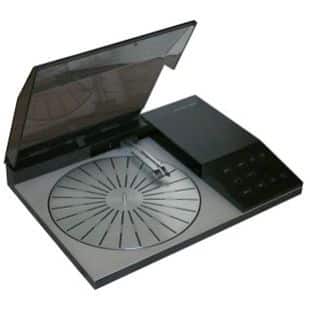
This was a re-badged Beogram 6002 but without the one way Datalink module.
It was fitted with the excellent MMC3 cartridge and could be used with other makes of amplifier. It was replaced by the much less substantial TX2.

This was a re-badged Beogram 6002 but without the one way Datalink module.
It was fitted with the excellent MMC3 cartridge and could be used with other makes of amplifier. It was replaced by the much less substantial TX2.
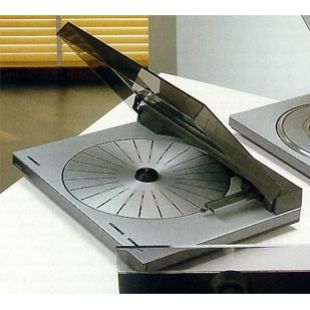
This tangential record player was a classic example of Bang & Olufsen’s attention to detail. It had automatic registration of record size and speed, and seven repeat functions. The turntable was based on Beogram 5005.
There was also the benefit of Bang & Olufsen’s patented chassis suspension and special tone arm design, which prevented vibrations from reaching the cartridge during play thus enhancing your pleasure and protecting your records.
The US TX2 had a 110V transformer but had no switching for other electrical voltages. As a comparison, most European models had an inbuilt transformer to allow for switching between other voltages.
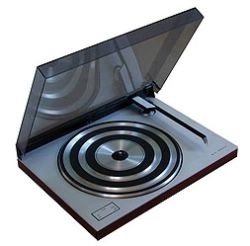
Beogram 3400 was designed to play back quadraphonic-encoded records and incorporated an MMC 5000 with a Shibita diamond stylus. An optional CD4 decoder could be specified to allow play back of that type of LP as well SQ discs which could be played by any record player.
Quadraphonic sound
Bang & Olufsen produced two quadraphonic systems in the 1970s. The top model was Beosystem 6000 which comprised Beomaster 6000 and Beogram 6000. Beogram 6000 was a development of Beogram 4000 in that it was a tangential tracking turntable. It had an inbuilt CD4 decoder which was switchable. When ‘on’ it would detect the presence of the carrier frequencies and a display would illuminate on the record deck’s display as ‘4ch’.
The output of the Beogram was at line-level whether in 2- or 4-channel mode. The deck was attached to Beomaster 6000 via a 5-pin DIN lead with all the pins being wired. In Beomaster 6000 there was a replaceable board with a SQ decoder as standard. This was manually switchable. The operator therefore still needed to know the type of quad recording that was to be played. The purpose of the removable board was to allow upgrading should the record industry ever get its act together and find a common standard!
The second system was based on Beomaster 3400 and Beogram 3400 which had a radial deck and a smaller and simpler receiver. This again had similar functions. Beomaster 4000 and a few others had a facility called Ambiophonics which used a system of simulated four track sound from stereo records. Two Bang & Olufsen cartridges were made for playing CD4 records:
MMC5000 used a fairly standard Shibata profile
The top of the range MMC6000 used a profile designed by one of their own engineers – Subir Pramanik – and which bore his name
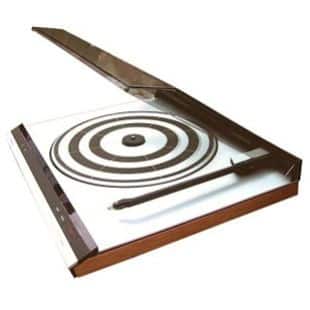
Beogram 2200/2400 were identical except that, when coupled to the Beomaster 2400, Beogram 2400 could also be operated by remote control.
To play records on either model it was necessary to simply press START and let the automatic system do the rest. As an additional safeguard, all functions could be operated with the protective lid closed. The electronic servo drive system kept turntable speed constant and correct, even during fluctuations in the mains supply. Careful arm geometry ensured that tracking angle was kept well below the level where it could affect the quality of the reproduced sound.
Bias effect was compensated automatically and needed no adjustment. The extreme lightness of the arm, together with the highly polished nude elliptical diamond carried by the MMC 20EN pickup in the 2400, resulted in an unusually low Effective Tip Mass (ETM). This means that your records would suffer very little wear, even after continual playing. Neither would they be damaged if the stylus was accidentally skidded across the surface.
Beogram 2400 could be made up as part of the Beosystem 2400 when linked together with other compatible Bang & Olufsen products.
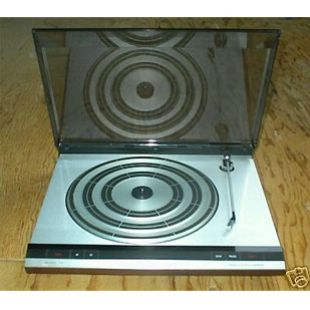
Beogram 3404 was designed specifically for the US market and was produced between 1980 and 1982. It incorporated an MMC 20E diamond stylus.
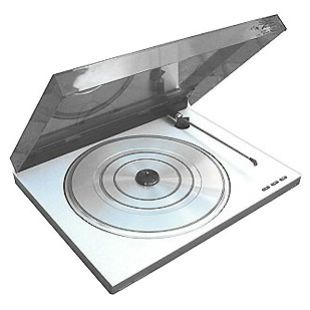
This fully-featured radial record player brought an extra dimension to all kinds of music systems.
It was ideal for those who love partying, with automatic anti-skating to prevent distortion, and Bang & Olufsen’s special chassis suspension which made the record player virtually ‘dance-proof’.
There was also automatic registration of record size and speed. Fine quality sound reproduction was provided by the lightweight tone-arm.
This deck was the last of the B&O radial tracking decks and was closely related to the excellent Beogram 5000. This is an excellent choice as a source for vinyl in a modern system requiring very little in the way of set up yet offering good audio performance.
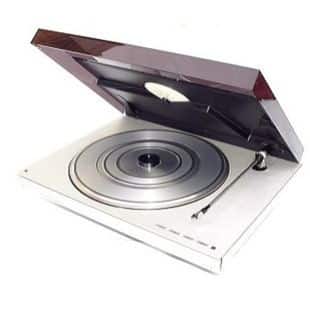
Beogram 5000’s radial-tracking record deck was the perfect match for Beomaster 5000. Operation was entirely automatic. One touch on the PLAY control started the motor and activated the deck’s logic circuits which assessed the size and correct speed of the record and instructed the arm to lower the stylus into the run-in groove.
This was a very fast-acting yet highly accurate control system which gave you music within about 8 seconds – far more quickly and gently than the human hand could guarantee. This system was also error-proof; for example, it was impossible to lower the stylus unless there was a record on the turntable, so expensive mistakes and accidents just couldn’t happen.
At the end of the record the motor automatically switched itself off and the arm returned to its rest position. If you wished, you could hear the same record over and over again automatically; it was necessary to just press PLAY once for each repeat required. Up to 7 consecutive performances could be pre-programmed in this way.
Beogram 5000’s sound quality was everything you would expect from so sophisticated a unit. The ultra-lightweight arm had built-in anti-skating and tracking weight adjustment. It carried the MMC 4 pickup with a framed elliptical diamond stylus that tracked the record groove accurately and with minimum wear.
As a final grace note there was also an interior light that switched itself on automatically when the lid was opened and stayed alight while the unit was in play.
When connected to Beomaster 5000, Beogram 5000 offered the added convenience of full infra-red remote control. The record deck could also be used as part of the Beosystem 5000.
Finish: brushed aluminium, dark grey translucent dust cover
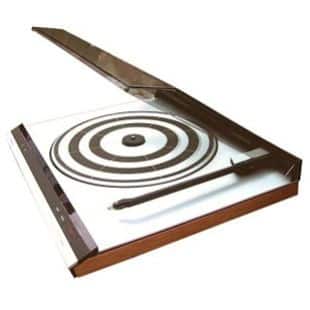
Beogram 2200/2400 were identical except that, when coupled to the Beomaster 2400, Beogram 2400 could also be operated by remote control.
To play records on either model it was necessary to simply press START and let the automatic system do the rest. As an additional safeguard, all functions could be operated with the protective lid closed. The electronic servo drive system kept turntable speed constant and correct, even during fluctuations in the mains supply. Careful arm geometry ensured that tracking angle was kept well below the level where it could affect the quality of the reproduced sound.
Bias effect was compensated automatically and needed no adjustment. The extreme lightness of the arm, together with the highly polished elliptical diamond carried by the MMC 20E pickup in the 2200, resulted in an unusually low Effective Tip Mass (ETM). This means that your records would suffer very little wear, even after continual playing. Neither would they be damaged if the stylus was accidentally skidded across the surface.
Beogram 2200/2400 could be made up as part of the Beosystem 2200 when linked together with other compatible Bang & Olufsen products.
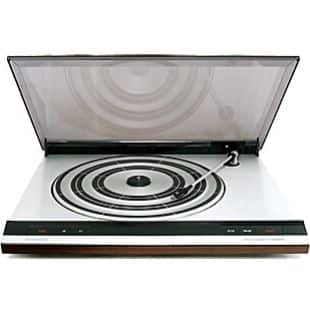
Beogram 2202 and Beogram 2402 replaced models 2200 and 2400 and were eventually replaced by Beogram 2404 (looking the same externally as the former units) in 1983.
To play records on the fully-automatic Beogram 2202/2402 decks, it was necessary to simply press “start” and let the integrated systems do the rest. As an additional safeguard, all functions could be operated with the protective dust lid closed.
Thanks to the fine polish of their elliptical diamonds, and the low mass of the arm, these Beograms got the very best from your records without inflicting any significant wear. Careful arm geometry ensured that tracking error was kept well below the level where it could affect sound quality. Skating effect was compensated automatically. Beogram 2202 was fitted with an MMC 20E pickup, while Beogram 2402 has an MMC 20EN. When coupled to the Beomaster 2400-2 FM stereo receiver, Beogram 2402 could be operated by remote control.
Beogram 2202 / 2402 could be made up as part of the Beosystem 1900 or Beosystem 2400, when linked together with other compatible Bang & Olufsen products.

Beogram 2202 and Beogram 2402 replaced models 2200 and 2400 and were eventually replaced by Beogram 2404 (looking the same externally as the former units) in 1983.
To play records on the fully-automatic Beogram 2202/2402 decks, it was necessary to simply press “start” and let the integrated systems do the rest. As an additional safeguard, all functions could be operated with the protective dust lid closed.
Thanks to the fine polish of their elliptical diamonds, and the low mass of the arm, these Beograms got the very best from your records without inflicting any significant wear. Careful arm geometry ensured that tracking error was kept well below the level where it could affect sound quality. Skating effect was compensated automatically. Beogram 2202 was fitted with an MMC 20E pickup, while Beogram 2402 has an MMC 20EN. When coupled to the Beomaster 2400-2 FM stereo receiver, Beogram 2402 could be operated by remote control.
Beogram 2202 / 2402 could be made up as part of the Beosystem 1900 or Beosystem 2400, when linked together with other compatible Bang & Olufsen products.